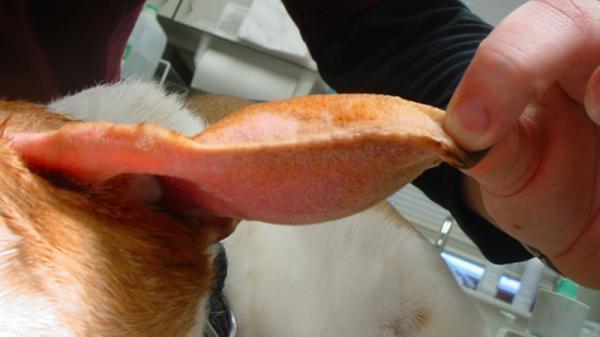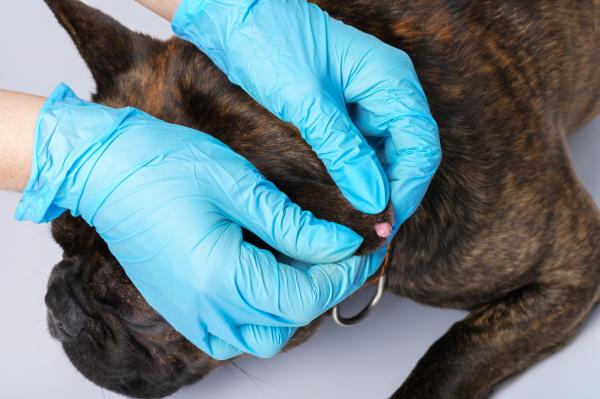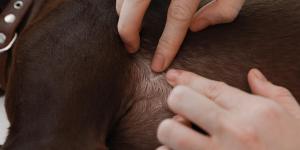Bump on My Dog's Ear - Dog Ear Hematoma



See files for Dogs
A bump on a dog's ear is likely due to an issue known as otohematoma in dogs. A type of ear hematoma, it can greatly vary in size, shape and texture, according to the individual dog. Not only do dogs use their ears to hear, but they are very important in maintaining balance. Any pathologies or other medical conditions which cause damage to the ears not only risk the dog's sense of hearing, but it can affect them in various other ways. The psychological damage hearing loss can cause is not something which should be underestimated.
At AnimalWised, we find out why there is a bump on my dog's ear. We look at the various causes of lumps, inflammation and other types of ear bumps, as well as what we might be able to do about them.
Dog ear hematoma
One of the most common reasons why a dog has a bump on their hear is due to otohematoma, also known as an aural or ear hematoma. This refers to an accumulation of blood between the cartilage of the ear and the skin. It is most commonly on the inside flap of the dog's ear, but it can occur on almost any part.
The most common cause of an hematoma in dogs is due to trauma. Blunt force such as being hit, being bitten by another dog or trapping their ears in a mechanism can rupture the ear's blood vessels. The ruptured blood vessels release blood between the skin and cartilage. The most common type of trauma is from the dog themselves as they try to scratch their ears or shake their heads for various reasons.
Although the action of the trauma causes this an aural hematoma in dogs, the reason for the trauma is usually the underlying cause of the agitation. Otitis, dermatitis and other types of ear swelling are caused by infections, allergic reactions and other factors. The itchiness results in the dog scratching. It is also likely caused indirectly by immune-mediated diseases which predispose the dog to ear infections and other problems.
Regardless of the cause, the hematoma separates the skin from the ear cartilage. This creates a characteristic swelling or bump in the dog's ear. If left untreated, the hematoma will clot and can form a seroma. In these cases, it is common for the granulation tissue that forms to adhere to the atrial cartilage. The result is a wrinkled or puckered ear pinna.
Treatment of dog ear hematoma
The treatment of otohematoma in dogs can vary depending on how far it has progressed. If you see a small bump of your dog's ear which has only recently developed, treatment is usually based on:
- Closed suction: the hematoma is punctured with a needle or catheter and the contents are completely drained.
- Bandage: once the blood has drained, it is important to place a bandage that keeps the ear cartilage in contact with the skin to promote healing.
In very large or otherwise serious otohematomas, it is necessary to resort to surgical intervention. Although it is more aggressive, it is also definitive. An incision is made under general anesthesia to drain the blood from the ear and remove any adhesions that have formed. It is then sutured with transfixing stitches that allow the skin and ear cartilage to remain attached. Postoperative bandages should be changed every 48 hours.
In addition to resolving the otohematoma, it is essential to establish a specific treatment for the cause that has triggered it. This is often dermatitis or external otitis in dogs. Otherwise, the aural hematoma is likely to reoccur.
You can find out in our related article the specific treatment for seroma in dogs if the hematoma has progressed to this stage.

Tumors of the ear
Another differential diagnosis to take into account when a bump appears on a dog's ear is tumors. Most neoplasms located in this region are usually benign, some of the most frequent being:
- Lipomas: benign, mobile tumors that are usually located at the base of the ear. Lipomas are a type of fatty tumor in dogs which often have an unknown cause. Although initially small, they can grow to considerable sizes.
- Histiocytomas: benign tumors of epithelial origin. They are usually small neoplasms with a rounded shape and smooth edges. The color is usually reddish, although the surface is often ulcerated by trauma, bleeding and scabbing. If you see red bumps on the inside of the dog's ear flap, it could be due to histioctytoma.
- Papillomas: benign neoplasms with a cauliflower-like appearance. They are irregular and relatively fragile. They are usually pale in color, although they ulcerate and bleed easily.
Less commonly, malignant tumors such as adenocarcinomas or mast cell tumors may occur. Mast cell tumors in dogs usually occur on the ear flap of the dog.
Treatment of tumors on dog ears
Regardless of their origin and malignancy, these tumors must be surgically removed to prevent future complications. Before surgery, it is necessary to perform a biopsy to make a histopathological diagnosis. This way the veterinary surgeon can determine the type of surgery, such as conservative or radical. They will also assess the need for complimentary treatments such as radiotherapy or chemotherapy for dogs.

Abscesses
Abscesses in dogs can occur in any tissue of the body where pus can accumulate. It is an acute inflammatory reaction that occurs due to bacterial infection. When abscess occur in a dog's ears, we can see bumps on the skin with the size of the bumps dependent on the extent of the infection.
Ear abscesses on dogs are commonly caused by fights with other animals. This is because the ears are vulnerable to biting by an aggressive dog and the bacteria in their mouths can infect open wounds. They can also be caused by any type of trauma or wound that has a secondary bacterial infection. These can be due to accidents, blows or even insect bites.
Treatment of abscess on a dog's ear
Generally, the treatment of abscesses is based on:
- Drainage of the abscess: the abscess which forms the bump on the dog's ear must be opened to empty the purulent content and remove the capsule.
- Antibiotic and anti-inflammatory therapy: a broad-spectrum antibiotic can be used or a culture is taken to perform antibiogram. This will determine the type of bacteria so the corresponding antibiotic can be administered.
Allergies
When you see lots of small bumps on a dog's ear, it is likely due to an allergic reaction. When a dog has a sensitivity to a particular allergen in their environment, their immune system will overreact and produce various symptoms. In acute cases, they can cause anaphylactic shock. However, many dogs develop lesser reactions such as small red bumps on their skin, including the skin on or in their ear.
The allergens to which the dogs are sensitive can be natural, such as plants toxic to dogs. They may also be due to chemicals and other manufactured products you have in the home, such as those you use to clean. Allergies can cause atopic dermatitis, a type of skin inflammation. This can present in small bumps, but when it progresses it can also cause skin lesions, purulent discharge and other issues.
Treatment of allergies in dogs
You will need to take the dog to a veterinarian. They will help to determine the allergen to which the dog has a sensitivity. This will then need to be removed from their environment. To relieve the symptoms of the allergic reaction, the vet will likely prescribe antihistamine medication suitable for dogs.
Other causes that produce bumps in a dog's ear
We have already provided the most common causes of a bump on a dog's ear. There are other reasons we might see bumps on a dog's ear which are less common. They include:
- Foreign body pyogranuloma: a subacute inflammatory process that is produced by the entry of a foreign body. One of the most common foreign bodies which produce this injury are foxtails in dogs. They can enter the ear canal and cause otitis, but they can also attach themselves to the ear pinnae. When polymorphonuclear cells invade the inflammation it can result in a pyogranuloma tumor. Treatment requires disinfection of the area and surgical removal of the neoplasm,
- Canine leproid granuloma: a chronic inflammatory process caused by bacteria of the genus Mycobacterium spp. It is characterized by the appearance of single or multiple nodules located on the head and ears. Surgical treatment of lesions is curative. It is the one seen in the image above.
- Sebaceous cyst: a non-inflammatory and non-tumorous lesion that consists of the formation of a nodular structure that contains sebum. Surgical removal is the most common curative treatment, but many are left untreated if they do not cause any issues.

What happens if I don't treat a bump on my dog's ear?
If a lump on a dog's ear such as dog ear hematoma is left untreated, several potential complications and consequences can arise. Some of the notable outcomes include:
- Ear deformity: without intervention, the hematoma can cause the ear flap to become swollen, thickened and deformed. This can lead to a permanent change in the shape and appearance of the dog's ear.
- Chronic pain: hematomas can be painful for the dog, and as the condition persists, the discomfort may become chronic. This can affect the dog's overall well-being and quality of life.
- Infection risk: an untreated hematoma can become a site for bacterial infection. The accumulated blood can provide a suitable environment for bacterial growth, leading to an infected hematoma. Infections can be more challenging to treat and may require additional medical attention.
- Scar tissue formation: the healing process without treatment may result in the formation of scar tissue within the ear flap. This can contribute to further changes in the ear's structure and may affect its flexibility.
- Recurring hematomas: in some cases, untreated hematomas may recur, especially if the underlying cause, such as ear infections or allergies, is not addressed. Recurring hematomas can be frustrating for both the dog and the owner.
To prevent these complications, it is advisable to seek veterinary attention promptly if a dog is suspected of having an ear hematoma. Treatment options may include drainage of the hematoma, addressing the underlying cause and providing appropriate medical care to promote healing and reduce the risk of recurrence.

This article is purely informative. AnimalWised does not have the authority to prescribe any veterinary treatment or create a diagnosis. We invite you to take your pet to the veterinarian if they are suffering from any condition or pain.
If you want to read similar articles to Bump on My Dog's Ear - Dog Ear Hematoma, we recommend you visit our Skin problems category.
- Sula, M.J. (2012). Tumors and tumorlike lesions of dog and cat ears . Vet Clin North Am Small Animal Pract; 42(6):1161-78.
- Risalde, MA Surgical Treatment of Dog Otohematoma. Applied anatomy in small animals. University of Cordoba.






 My puppy has small bumps on the inside of her ear.
My puppy has small bumps on the inside of her ear.



